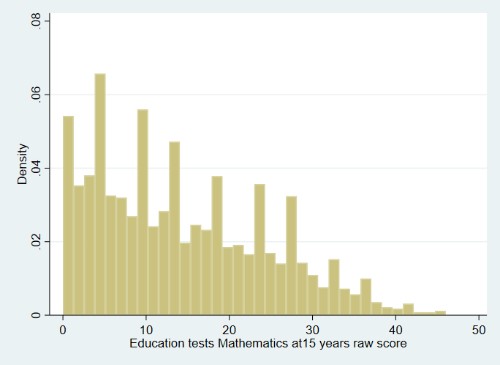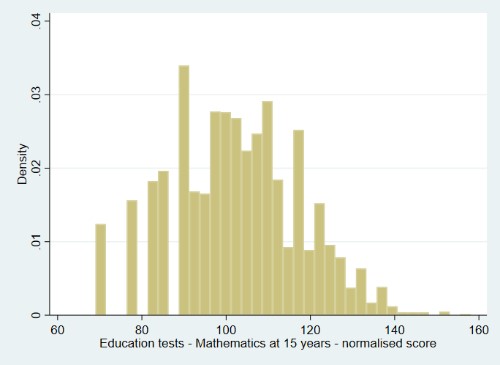The MRC National Survey of Health of Development (NSHD) assessed their cohort members (CMs) during the study’s age 15 sweep using the Mathematics Test.
Details on this measure and the data collected from the CMs are outlined in the table below.
| Year of data collection: | 1961 | |
| Domain: | Verbal (arithmetic) | |
| Measures: | Mathematical ability/knowledge | |
| Mathematical achievement | ||
| CHC: | Gq (Quantitative Knowledge) | |
| CLOSER Source: | Explore this sweep in CLOSER Discovery: NSHD 1961 (Age 15) (opens in a new tab) | |
| Administration method: | Teacher; face to face; pen and paper | |
| Procedure: | Participants were administered a 47-item mathematics test, which tested arithmetic, geometry, trigonometry, and algebra. | |
| Duration: The total time of administration was approximately 30 minutes (25 minutes working time). Data were heavily positively skewed, indicating the test was too difficult. | ||
| Link to questionnaire: | https://skylark.ucl.ac.uk/NSHD/lib/exe/fetch.php?media=questionnaires:1961_sm_nf4.pdf (opens in new tab) | |
| Scoring: | One mark for each correct item (0 - 47) | |
| Item-level variable(s): | Not currently available | |
| Total score/derived variable(s): | M15R, M15R61, M1561, M15N | |
| Descriptives: | Raw score | Normalised score |
| N = 4,015 | N = 4,015 | |
| Range = 0 - 46 | Range = 69 - 158 | |
| Mean = 14.26 | Mean = 102.59 | |
| SD = 10.21 | SD = 15.30 | |
(click image to enlarge) | (click image to enlarge) |
|
| Age of participants (months): | Mean = 174.54, SD = 2.12, Range = 172-182 | |
| Other sweep and/or cohort: | None | |
| Source: | Pigeon DA. Details of the fifteen years tests. In: Douglas JWB, Ross JM, Simpson HR, eds. All Our Future. London: Davies, 1968; Appendix 1. | |
| Technical resources: | None | |
| Example articles: | Richards, M., Shipley, B., Fuhrer, R., & Wadsworth, M. E. (2004). Cognitive ability in childhood and cognitive decline in mid-life: longitudinal birth cohort study. BMJ, 328(7439), 552. | |
| Cooper, R., Richards, M., & Kuh, D. (2017). Childhood cognitive ability and age-related changes in physical capability from midlife: Findings from a British birth cohort study. Psychosomatic Medicine, 79(7), 785. | ||
Go to:
- Overview of all cognitive measures in NSHD
- Overview of childhood cognitive measures across all studies
This page is part of CLOSER’s ‘A guide to the cognitive measures in five British birth cohort studies’.
